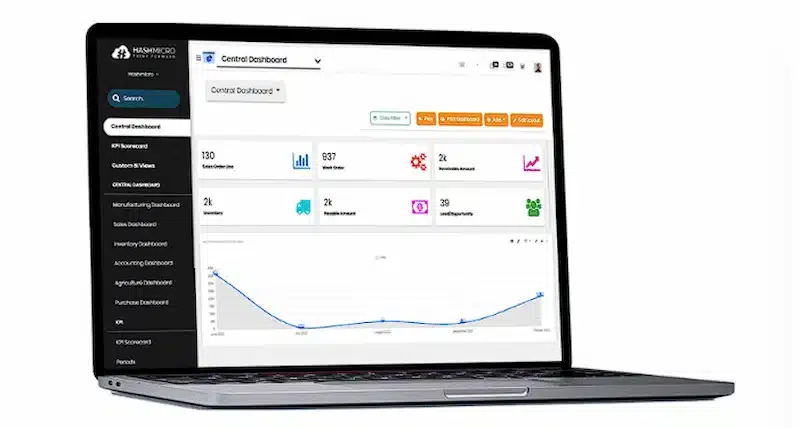As an inventory professional, you must understand that the presence of raw materials is important in the business. Without proper management of raw materials, companies can experience serious problems, such as production delays and losses due to shortages or overstock. This is why understanding raw material inventory is important.
Raw material inventory is the inventory of raw materials stored by the company before being used in the production process. These raw materials include all basic materials that have not been processed into finished products. Proper management of raw material inventory ensures a smooth production process.
However, you may still be asking why understanding raw material inventory is important and what you need to understand about this method. Therefore, continue reading this article to get the answers you want and make raw material management in your company efficient!
Table of Contents

Key Takeaways
|
What is a Raw Material Inventory?
Raw material inventory is the inventory of raw materials owned by the company to be used in the production process. These raw materials are basic materials that have not been processed or processed into finished products.
In various industries, such as manufacturing, food, or automotive, raw materials can be in the form of components that are transformed through the production process. Raw material inventory management plays an important role in maintaining the balance between production needs and raw material availability.
Good management ensures the company has enough raw materials to meet production demand without creating excess inventory that could increase storage costs or damage materials. Raw material inventory also helps companies optimize operational costs.
With proper inventory management, companies can determine when it is ideal to purchase raw materials in appropriate quantities. This allows the company to maintain efficiency in using resources and costs.
Therefore, efficient raw material inventory management not only maintains smooth production but also increases the company’s overall profitability.
Commonly Used Techniques for Managing Raw Material Inventory
We have discussed the definition of raw material inventory before. Next, we will discuss the techniques/methods commonly used to manage raw material inventory efficiently. Below is an explanation of the various methods that are commonly used:
Just-in-Time (JIT)
The JIT method aims to minimize the amount of raw materials stored in the warehouse by only ordering raw materials according to production needs. This means that raw materials arrive exactly when they are to be used in production, thus reducing storage costs and the risk of overstocking.
This technique is very useful in reducing waste, but requires very good coordination with suppliers to avoid delays in delivery.
Economic Order Quantity (EOQ)
EOQ is a method for determining the optimal amount of raw materials to order each time an order is placed. The goal of EOQ is to minimize the total cost of inventory, which includes storage costs, ordering costs, and stock shortage costs.
Companies can use a mathematical formula to calculate the ideal order quantity that balances ordering frequency and storage costs.
ABC analysis
This method involves grouping raw materials based on their value. Typically, raw materials are divided into three categories: A (high value and low volume raw materials), B (medium value and medium volume raw materials), and C (low value but high volume raw materials).
This method focuses stricter management on category A to ensure these important raw materials never run out and inventory costs are controlled. The company can then allocate the right resources and attention to each inventory group.
First-In, First-Out (FIFO)
This technique ensures that the raw materials that have been in the warehouse the longest (first-in) are used first in production (first-out). The FIFO method is often used for raw materials with a limited shelf life, such as food or medicine, to avoid spoilage or expiration.
Material Requirements Planning (MRP)
MRP is a computer-based system used to plan raw material requirements based on production schedules. Taking into account existing orders, production time, and delivery schedules, MRP helps ensure that the required raw materials are available on time and in the right quantity, thus avoiding shortages or overstocks.
How to Calculate Raw Material Inventory
There are several methods that can be used to calculate raw material inventory, depending on the purpose of the calculation, such as determining the value of inventory or analyzing the use of raw materials. Here is how to calculate the raw material inventory formula:
1. Calculating the inventory value of available raw materials
The value of raw material inventory formula is calculated by summing up the cost of raw materials owned by the company at the end of a certain period. The formula is
Raw Material Inventory Value = Initial Inventory + Purchases During the Period – Ending Inventory
- Initial Inventory The amount of raw materials available at the beginning of the period
- Purchases During the Period Total raw materials purchased during the period
- Ending Inventory The amount of raw materials remaining at the end of the period.
2. Calculating turnover ratio
To find out how quickly raw materials are used in the production process, you can calculate the inventory turnover ratio using the formula:
Inventory Turnover Ratio = Average Raw Material Inventory ÷ Cost of Raw Materials Used
Example: San Miguel Corporation (SMC) – Beverage Manufacturing
San Miguel Corporation (SMC), a well-known food and beverage company in the Philippines, uses raw materials like barley, hops, sugar, and water to produce its products. To understand how efficiently they use their raw materials, we can calculate their Inventory Turnover Ratio using a simple method.
Step 1: Find the Average Raw Material Inventory
First, we take the raw material inventory at the start of the period (₱400 million) and at the end of the period (₱600 million). The average inventory is the sum of these two amounts divided by two.
- (₱400 million + ₱600 million) ÷ 2 = ₱500 million
Step 2: Calculate the Inventory Turnover Ratio
Now, we take the total cost of raw materials used during the period (₱1.2 billion) and divide it by the average raw material inventory (₱500 million).
- ₱1.2 billion ÷ ₱500 million = 2.4
What Does This Mean?
An inventory turnover ratio of 2.4 means that SMC uses up and restocks its raw materials about 2.4 times within the given period.
- A higher ratio means materials are moving quickly, which is good for efficiency but could risk running out of stock.
- A lower ratio suggests slow movement, which could lead to excess inventory and higher storage costs.
By analyzing this number, SMC can adjust its raw material orders to maintain the right balance.
How to Manage Raw Material Inventory
Here are 5 steps that can be taken to keep raw material inventory management efficient and minimize errors:
1. Use an automated inventory management system
Implementing an automated inventory management system is essential to monitor raw material stocks in real-time. These systems allow for accurate stock counting and tracking, reducing the risk of manual errors, such as improper data input or incorrect calculations.
One system that you can use is the cloud inventory system from HashMicro. This system is specifically designed to meet various inventory needs, one of which is raw material inventory management. To facilitate this, HashMicro equips this raw material inventory management system with a variety of comprehensive features.
Schedule a free demo by clicking here!
You may also want to check out our previous article on WMS recommendations.
2. Accurate forecasting of raw material requirements
Performing proper forecasting based on historical data, market trends, and anticipated demand is very important. With accurate forecasting, companies can know when and how much raw materials to order. This helps prevent overstock or stockouts, which can lead to costly waste or production disruptions.
3. Periodic inventory audits and checks
Conducting audits and physical checks of raw material inventory on a regular basis is an important step to ensure inventory data matches physical stock quantities. Periodic audits can help companies identify potential errors, such as missing raw materials, damage, or data discrepancies, so that corrective steps can be taken immediately to avoid bigger problems in the future.
4. Apply the just-in-time (JIT) method
Just-in-Time is a method that organizes the ordering of raw materials based on actual production needs. With this system, companies only order raw materials when needed, reducing storage costs and the risk of overstocking. This method is very effective in improving the efficiency of raw material management, but requires good coordination with suppliers to ensure timely delivery.
5. Application of the first-in, first-out (FIFO) method
It is important to apply the FIFO method for raw materials with a limited shelf life, such as food ingredients or medicines. This means that the raw materials that first enter the warehouse will be used first in production. Thus, the risk of damage or expiration of raw materials can be reduced, thereby minimizing waste and maintaining the quality of the products produced.
Implement Efficient Raw Material Inventory Management with HashMicro’s System

HashMicro’s inventory management system is one of the best in the Philippines and can be a top choice for simplifying and improving the efficiency of inventory management, including raw material inventory management. HashMicro does not limit the number of users to allow inventory management to be overseen by multiple people at once, increasing transparency.
Furthermore, the HashMicro system can be integrated with other systems, such as accounting, HRIS, warehouse storage systems, and many more. You also don’t need to worry about optimizing this system if your business grows because HashMicro has extensive scalability to ensure the system remains optimal as the business grows. Interesting, isn’t it?
Here are the features offered by the HashMicro inventory system:
- RFID Warehouse rack stock in out automation: Automates the tracking of stock in and out movement on warehouse racks, improving efficiency and accuracy of inventory management.
- Run Rate Reordering Rules: Forecast product quantities based on market trends and ensure the warehouse has enough items to meet demand without overstocking or understocking.
- Stock Reservations & Reporting: Ensure availability of desired items and manage inventory more efficiently.
- Consignment Management: Manage stock updates, sales tracking, and consignor payments. This system allows companies to maintain consignments more efficiently and strengthen business relationships with those who provide consignment goods.
Conclusions
In conclusion, efficient raw material inventory management is very important for the company’s smooth operation, especially in the production process. By using the right methods such as automated management systems, accurate forecasting, and the application of techniques such as Just-in-Time (JIT) and First-In, First-Out (FIFO), companies can avoid errors such as overstocking or understocking, reduce storage costs, and improve production efficiency.
Implementing an inventory management software like HashMicro’s inventory software can be an alternative solution to make your raw material inventory management more efficient and error-free. If you are curious about how the HashMicro system works, schedule a free demo by clicking here!





































